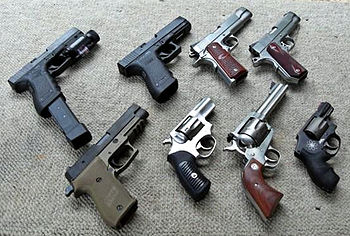 |
| Schietsport, vrouwen met pistool / Sports, shooting. Women with pistols (Photo credit: Nationaal Archief) |
DISCLAIMER - This is a non-political site that is geared to help writers write it right. I am presenting information to help develop fictional characters and fictional scenes. In no way am I advocating any position or decision.
Fiona -
Today I am interviewing Kelli about conceal carry. Hey Kelli, are you ready?
Kelli -
Yep. I'm cooking deer meat, so I may get up and walk off for one second if you wonder why it takes me a minute.
 |
| English: Handgun showing self lighting Tritium sights. These sights are commonly referred to as night sights and allow use in low-light and night conditions. (Photo credit: Wikipedia) |
Fiona -
Bahaha. You do that. Kelli, how would you describe yourself to my readers?
Kelli -
I'm a 'down home' type of person. I like being in nature and with plants and animals and being able to do things for myself as much as possible.
I was taught not to ask for help, that shows weakness. Friendly, helpful, but not a doormat to anyone. Growing up, I rode motorcycles, tried to rehab animals that were hurt, went camping with my family and spent most of my time outside playing. I grew up in southern West Virginia.
 |
| Wikipedia |
Fiona -
Kelli is being modest. She also holds an MA in education, qualifies to test for her third degree black belt, and is a Tae Kwon Do instructor. Okay, girlfriend, let's talk conceal carry. Watcha got in your purse?
Kelli -
In my purse I have a journal, my wallet, and some chapstick. I don't carry in my purse!
Fiona -
Where do you like to carry, what do you like to carry and why do you do it?
Kelli -
I carry a .380 Ruger LCP and I use a Smart Carry for that (goes around the waist, deeply concealed). I carry for the same reason people wear a seat-belt, not because I think I will need it, but because it is a good idea for that 'just in case' moment.
 |
| English: Clockwise start at the top left: Glock G22, Glock G21, Kimber Custom Raptor, Dan Wesson Commander, Ruger sp101, Ruger Blackhawk .357, Sig Sauer P220 Combat. (Photo credit: Wikipedia) |
Fiona -
Have you ever needed it?
Kelli -
Thankfully no, I have never had to draw! I also keep a .357 Ruger revolver in my console of my truck.
Fiona - And also a knife?
Kelli -
As an herbalist, I always carry a good pocketknife, Benchmade!
Fiona -
So let's start at the beginning - when did you decide to start carrying and was there any particular reason?
Kelli -
When I moved to CA we couldn't take a lot of our guns with us because of the law. So I left most of them at home in WV (we took one) after left there I moved to VA, and I realized there were times I was in some 'not so good' areas (not like home in WV where we know everyone).
I started thinking about how I had lost my shooting skills being gone and how I would like them to get sharpened again. So I took a few classes and then saw they had a conceal carry class and thought that would be a good idea. So I went to the class, got my certification, and went through with the permit!
My husband had been in Iraq, and I remember feeling a little more vulnerable during that time. I thought I should keep my shooting skills up and get more proactive with my protection of the house and of my daughter. Especially when we were out (we often traveled out of town on agility trials and went back home to WV a lot. (Kelli trains dogs for agility trials.)
Fiona -
You like to use a Smart Carry and even made a YouTube video, right?
Kelli -
Yes. I love the Smart Carry, and there were no videos showing how it fit women and how good it was for conceal for women. Most of the videos showed men only. So I wanted to show how easy it was for other women who may be thinking about it.
Fiona -
Thanks for sharing! When you read books or watch videos of women with guns - I'm sure you see mistakes. What are some of the things that you would like writers to know about women carrying concealed?
Kelli -
One of my biggest issues with the way women carry is that in most cases they think it is safe or preferable to carry in their purse. I am not saying this is wrong, but I don't feel it is the safest and quickest way to access your gun. Someone who wants to rob you may take your purse (now they have your gun, too).
 |
| English: An XOXO brand purse. (Photo credit: Wikipedia) |
Fiona -
Okay Ladies, don't put your gun in your purse. And writers, now you can see how this can go wrong for our heroines - if you're trying to make the scene go bad.
Kelli -
Right. If you have your gun on you, you can access it quicker and if you walk off from your purse there is no risk of someone (maybe a child) getting your gun. To me, that is very dangerous, and I don't care for it.
Youtube of a bra - carry
Fiona -
Agreed. What about the chick who is afraid, and so she goes to the gun shop, buys a gun, and sticks it in her purse - do you like that one?
Kelli -
Yikes! Know your gun. Practice with it. Practice drawing from different angels, different scenarios.
Fiona -
You mean I won't have time to hit my favorite pose and do some cleansing yoga breaths?
Kelli - Uhm, no. Fear can cloud your judgment, I would suggest that person get with an instructor and help her overcome her fears, and teach her how to use and carry her gun appropriately to fit her situation and circumstances (whatever they may be).
Fiona -
Any other advice for the scared rabbit heroine?
Kelli -
Don't be scared. Be prepared.
Fiona -
We should make a T-shirt.
Kelli -
Bahaha. Yes. But that is my best advice on anything. Don't be scared, find ways to help yourself feel more confident about your self-defense skills (maybe take a women's self-defense class, martial arts, etc) but fear is NOT your friend! Confidence is your friend!
Fiona -
Any ethics we need to keep in mind about conceal carry?
Kelli -
If I am carrying, I usually take my gun off before going into someone's home, unless I know they are gun-friendly, and I usually do tell them. I ask them if that makes them uncomfortable (though I usually remove it). I think that is just being a good friend. If I know they are okay with it and carry themselves then I wouldn't think about it as much.
Fiona -
Where can you get in trouble carrying - for writers who don't use guns, can you make a quick list? That was cryptic. I mean like a bar, the courthouse...
Kelli -
That can depend on the state (you should always follow your state laws) but generally government agencies and schools are the top ones. I am not an expert in that so anyone interested needs to research that thoroughly and keep a list on your refrigerator, memorize, keep it in your car, etc. you need to know the law, if you don't you are not ready to carry!
Advice for the heroine carrying concealed?
Kelli -
Well my daddy told me this, "Never put your finger on the trigger unless you are ready to kill what is in front of you," and that is a big thing to consider. So my best advice is really think about it. Is your heroine willing to squeeze that trigger if she has to? If not, then she shouldn't carry. If your heroine hesitates, the gun can and will be used against her. Your heroine has to be 1000% sure of her ability to defend her life (or her family's). This is not play time; this is serious. And she needs to be serious about it.
Me -
And now for the last words...
Kelli -
My final thought? My life is worth defending, is yours? I really would like to see more women either carry, learn self defense skills, or something to protect themselves, sadly this world is not rainbows and unicorns. Women are often victims; it is time to end that!
Fiona -
Amen. Thanks to Kelli for sharing her insights and thanks to you for stopping by.
Thank you so much for stopping by. And thank you for your support. When you buy my books, you make it possible for me to continue to bring you helpful articles and keep ThrillWriting free and accessible to all.











.jpg)









.JPG)
.JPG)



.JPG)












